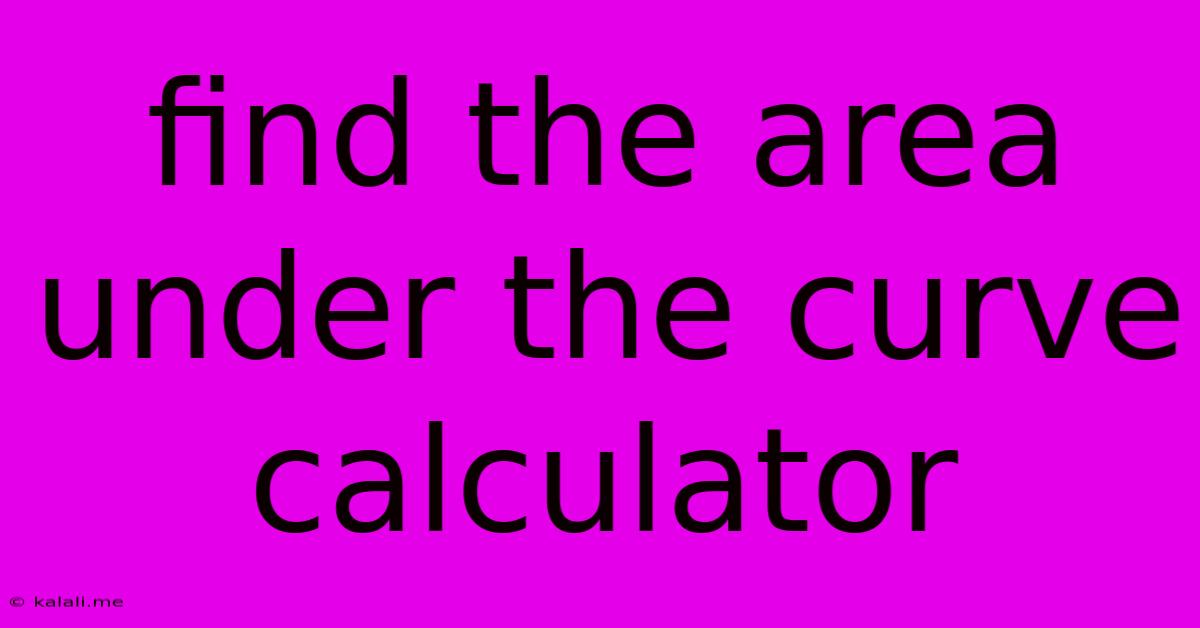Find The Area Under The Curve Calculator
Kalali
Jun 13, 2025 · 3 min read

Table of Contents
Find the Area Under the Curve Calculator: A Comprehensive Guide
Finding the area under a curve is a fundamental concept in calculus with applications across various fields like physics, engineering, and economics. Manually calculating this area can be complex, especially for intricate functions. Thankfully, numerous online "find the area under the curve calculator" tools simplify this process, making it accessible to everyone. This article will explore the concept, its applications, and guide you on effectively using these calculators.
What is the Area Under the Curve?
The area under a curve, more formally known as a definite integral, represents the area bounded by the curve of a function, the x-axis, and two vertical lines representing the limits of integration. This area gives us valuable insights into accumulated quantities over a specific interval. For example, if the curve represents the velocity of an object over time, the area under the curve represents the total distance traveled. Similarly, if the curve represents the rate of water flow into a tank, the area under the curve represents the total volume of water accumulated.
Methods for Calculating the Area Under the Curve:
While calculators provide a quick solution, understanding the underlying mathematical principles is crucial. Several methods exist for calculating this area:
-
Analytical Methods: These involve using calculus techniques, specifically integration. This is the most precise method but can be challenging for complex functions.
-
Numerical Methods: When analytical integration is difficult or impossible, numerical methods like the trapezoidal rule, Simpson's rule, or Monte Carlo methods provide approximate solutions. These methods break down the area into smaller shapes (trapezoids, parabolas, etc.) whose areas are easier to calculate, then sum them up. These are the methods often employed by online calculators.
How to Use an Area Under the Curve Calculator:
Most online calculators follow a similar process:
-
Input the function: Enter the mathematical expression representing your curve. Make sure to use correct syntax, often similar to what you'd use in a programming language or a graphing calculator. Common functions and operators (sin, cos, tan, exp, ln, +, -, *, /, ^) are usually supported.
-
Specify the integration limits: Define the interval over which you want to calculate the area. This involves inputting the lower and upper bounds (a and b) for the x-values.
-
Select the method (if available): Some calculators allow you to choose the numerical integration method. The default method is usually accurate enough for most purposes.
-
Execute the calculation: Click the "Calculate" or equivalent button to initiate the computation.
-
Interpret the results: The calculator will provide the calculated area under the curve. Remember that numerical methods provide approximations; the accuracy depends on the chosen method and the complexity of the function.
Applications of Area Under the Curve Calculations:
The applications are vast and span numerous disciplines:
- Physics: Calculating displacement from velocity, work done by a force, or total charge from current.
- Engineering: Determining the total strain on a material, calculating the volume of irregular shapes, or analyzing signal processing data.
- Economics: Calculating total revenue from a marginal revenue curve, or accumulated costs over time.
- Probability and Statistics: Finding probabilities associated with continuous probability distributions.
Choosing the Right Calculator:
Several online area under the curve calculators are available. Look for calculators that:
- Offer a wide range of function support: Ensure it can handle the types of functions you'll be working with.
- Provide clear and understandable results: The output should be easy to interpret.
- Allow for choosing numerical integration methods (if needed): This offers more control and allows for comparison of results.
- Is user-friendly and easy to navigate: A well-designed interface makes the calculation process straightforward.
In conclusion, "find the area under the curve calculators" are invaluable tools for simplifying complex calculations. Understanding the underlying principles and choosing the right calculator will allow you to effectively utilize these resources across various applications. Remember to always double-check your inputs and consider the limitations of numerical methods for highly complex functions.
Latest Posts
Latest Posts
-
Example Of Open Loop Control System
Jun 14, 2025
-
Which Of The Following Is A Weak Electrolyte
Jun 14, 2025
-
Which Of The Following Statements Are True Regarding Electric Generators
Jun 14, 2025
-
Which Era Is Referred To As The Age Of Mammals
Jun 14, 2025
-
All Of The Following Are Classified As Long Bones Except
Jun 14, 2025
Related Post
Thank you for visiting our website which covers about Find The Area Under The Curve Calculator . We hope the information provided has been useful to you. Feel free to contact us if you have any questions or need further assistance. See you next time and don't miss to bookmark.